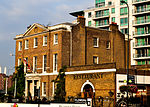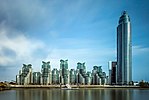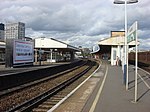DAMAC Tower Nine Elms
Buildings and structures under construction in the United KingdomKohn Pedersen Fox buildingsNine ElmsProposed skyscrapers in LondonResidential skyscrapers in London ... and 3 more
Skyscrapers in the London Borough of WandsworthUse British English from June 2019Versace
DAMAC Tower Nine Elms is a 50-storey, 170-metre high skyscraper located at 69-71 Bondway, Nine Elms, London. Originally to be completed by 2020, the tower is now scheduled to open in 2021. The tower consists of 360 apartments, with interiors are designed by Donatella Versace. The apartments went on sale on 21 July 2015, with all the Thames-side apartments having been "pre-sold". Prices start at £711,000 for a studio.
Excerpt from the Wikipedia article DAMAC Tower Nine Elms (License: CC BY-SA 3.0, Authors).DAMAC Tower Nine Elms
Bondway, London Vauxhall (London Borough of Lambeth)
Geographical coordinates (GPS) Address Website External links Nearby Places Show on map
Geographical coordinates (GPS)
| Latitude | Longitude |
|---|---|
| N 51.4841 ° | E -0.1246 ° |
Address
DAMAC Tower (AYKON London One)
Bondway
SW8 1SQ London, Vauxhall (London Borough of Lambeth)
England, United Kingdom
Open on Google Maps









